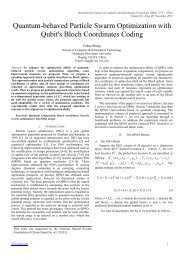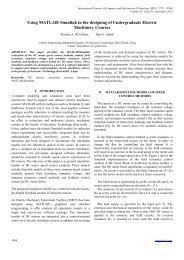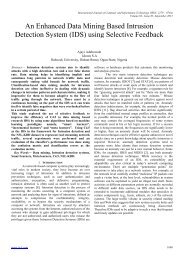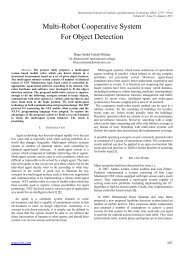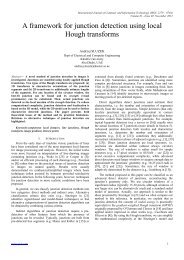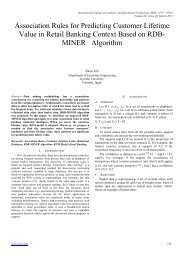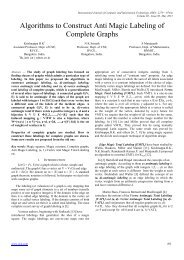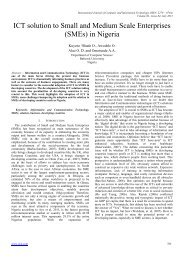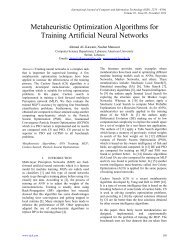Enhanced Performance and Global Reachability Of Manet Nodes ...
Enhanced Performance and Global Reachability Of Manet Nodes ...
Enhanced Performance and Global Reachability Of Manet Nodes ...
Create successful ePaper yourself
Turn your PDF publications into a flip-book with our unique Google optimized e-Paper software.
International Journal of Computer <strong>and</strong> Information Technology (ISSN: 2279 – 0764)Volume 02– Issue 04, July 2013the MANET as well as out of the MANET. This could beachieved through one of two approaches; NAT i.e. NetworkAddress Translation or Auto-Address Configuration basedapproach.In the first approach, basic access networks that have onlybeen designed for single host connections would not be able tosupport the introduction of MANETs. This approach wouldrequire potential access routers to be installed on large scale, ifa single Gateway with a bigger cluster of MANET nodesattached to it, is roaming in the another network.The problem that arises in the second approach is, thenetwork efficiency would degenerate with an increase in thenumber of nodes within a MANET. As the size of MANETincreases, the topology information, for each access network,has to travel further more hops away from the access point.In case of NEMO, the mobile device or the MR i.e. MobileRouter, which behaves as the gateway to the network, controlsthe incoming <strong>and</strong> outgoing packets. This can be achieved usingthe HA situated on the Home Network of the MR. In this case,HA forwards the packets, destined for nodes attached to theMR. When MR is mobile, it configures a new address CoA i.e.Care-of-Address, based on the prefix of the access network towhich it is currently connected. Then MR registers the newCoA with it’s HA <strong>and</strong> establishes a bi-directional tunnel. Thisregistration process is known as BU i.e. Binding Update. Whena node attached to the MR sends a packet into the internet,these packets are first tunneled via the HA <strong>and</strong> conversely, thepackets that are sent from a node in the internet towards MR,HA intercepts them <strong>and</strong> then forwards to MRs current locationvia the bi-directional tunnel.But it is still unable to provide global reachability <strong>and</strong>session persistence without packet loss <strong>and</strong> h<strong>and</strong>over latency.For this one solution is to integrate the existing MANETrouting protocol OLSR with the NEMO protocol. In spite ofthe effort, the bottleneck that still persists is congestion,h<strong>and</strong>over latency <strong>and</strong> packet loss. Hence the proposed solutionintegrates AODV routing protocol with the NEMO protocol<strong>and</strong> extends pre-registration technique in NEMO.II.SURVEYThe author in the paper [1] the author has proposed aframework for the Ad hoc On-dem<strong>and</strong> Distance Vector(AODV) routing protocol can be used for internetworkingbetween wireless ad hoc networks <strong>and</strong> the IPv6 Internet. Thesolution in this paper relies on the signaling the AODV to findan access providing Internet Gateway that is able to distribute aglobally routable prefix for the ad hoc network. The author inthe paper[2], has proposed a protocol for mobile nodes in an adhoc network for the mobility that offers quick adaptation todynamic link conditions, low processing, memory overhead,low network utilization, <strong>and</strong> determines unicast routes todestinations within the ad hoc network.The author in the paper [5] has proposed to provide forextended internet connectivity for IP h<strong>and</strong>off in MANET. Wehave considered a mobile node to a fixed host that is connectedto a network, <strong>and</strong> the propose architecture enables a mobilenode in the MANET to change its IP address more frequentlydue to the deployment of auto-configuration, globalconnectivity, <strong>and</strong> hierarchical addressing schemes.The author in the paper [4] has explained about thetransition mechanism for IPv4 to IPv6 protocol. This solutionattempts to provide transparent routing between IPv6 endnodes <strong>and</strong> IPv4 end nodes. In the paper [6], the author hasproposed a method for IPv6 soft h<strong>and</strong>over that can be appliedto the network mobility over heterogeneous access networks toreduce the packet loss.In the paper [7], the Optimized Link State Routing (OLSR)protocol for mobile ad-hoc networks is described. This paperdescribes an optimization of the classical link state algorithmtailored to the requirements of a mobile wireless LAN. Thekey concept in this paper is Multipoint Relays (MPRs). It isdescribed here that this technique substantially reduces themessage overhead as compared to a classical floodingmechanism, where every node retransmits each message whenit receives the first copy of the message. Only the MPR nodescan generate the link state information in this protocol. For thesecond optimization the number of control messages flooded inthe network is reduced.In the paper [8], the author designed architecture to supportthe network mobility as NEMO basic support protocol. It isdiscussed in the paper that it enables Mobile Networks toattach to different points in the Internet <strong>and</strong> it is an extension ofMobile IPv6 which allows session continuity for every node inthe Mobile Network as the network moves from one point ofattachment to other point of attachment.III.PROPOSED SYSTEMA. System ArchitectureAs discussed earlier, global reachability of MANET nodesimplies a node within mobile ad-hoc network remainsreachable whether it is in home network or mobile or roamingi.e. foreign network. To make a MANET node reachable,whenever it is able to establish direct connection to the internet,it sets up a bi-directional tunnel with it’s HA. At the same time,all the other nodes in a MANET maintain communication withone another in the network using mobile ad-hoc routingprotocol. One of the nodes in the network plays the role of aGateway, where it has to establish a direct connection to theinternet. By extending the node‘s connection with its HA, allthe other nodes in the MANET forward their packets into theinternet. When the packets go out of MANET, then the NEMOprotocol is activated. Thus a node in the MANET can establishits own direct connection to the internet or it can establish aconnection to the internet using existing Gateway.In case one of the nodes in the MANET establishes directconnection; the immediate next step is to obtain topologicallycorrect CoA. In the other case where the node has indirectconnection, the packets are routed in <strong>and</strong> out of the MANETbased on the tunnel that other nodes <strong>and</strong> the Gateway maintainswith its HA. When one of the node performs a Binding Updatevia a Gateway, the HA must track the tunnel through which thewww.ijcit.com 762



